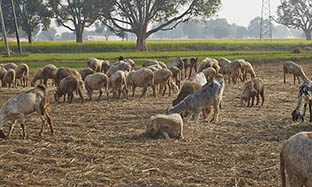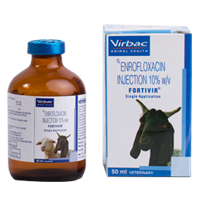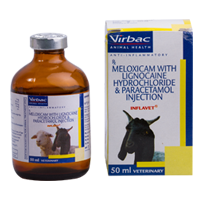Why Foot rot needs proper care and treatment?
Ovine foot rot was first reported in 1869. It is an infectious, contagious disease of sheep that causes severe lameness and economic loss from decreased flock production. In a Virginia survey, approximately 21 percent of the producers considered foot rot to be a serious health problem in their flocks. With current understanding of the disease, and aided by drugs and vaccines, control and elimination of the disease should be the goal of all sheep producers.
Ovine foot rot is caused by an interaction of two anaerobic (without oxygen), Gram (-) bacteria, Bacteroides nodosus (formerly Fusiformis nodosus) and Fusobacterium necrophorum (formerly Sphaerophorus necrophorus). Fusobacterium necrophorum is a normal inhabitant of the ruminant digestive tract and in wet weather may interact with another bacteria, Corynebacterium pyogenes, to produce foot scald, an infection of the skin between the toes.
Lameness is usually the major sign of an infected animal, although sheep with an early infection may not exhibit lameness. The area between the toes first becomes moist and reddened. Then the infection invades the sole of the hoof, undermining and causing separation of the horny tissues.
The bacteria that causes foot rot, Bacteriodes nodosus, is spread from infected sheep to the ground, manure, bedding, etc., where it is then picked up by noninfected sheep.
It is always easier and less expensive to prevent foot rot than to treat it after it has become established. To remain disease free, there are five management principles that will help keep foot rot from being introduced into a clean flock.
- Never buy sheep with foot rot or from a flock infected with foot rot, even if the animal(s) appear unaffected.
- Avoid buying sheep at sale yards or livestock markets where clean and infected sheep may have been commingled or run through the same area.
- Avoid using facilities (trails, corrals, dipping areas) where infected sheep may have been in the last two weeks.
- Never transport sheep in a vehicle that has not been properly cleaned and disinfected.
- Trim and treat the feet of all new arrivals, then re-examine them periodically during the 30-day isolation period.
The control of ovine foot rot is based on several management practices that decrease predisposing factors, and on the treatment and immunization of infected and susceptible sheep. The best results are obtained when several of the following methods are combined.
- Foot trimming: This reduces the number of cracks and crevices where bacteria can hide, removes infected hoof, and exposes the organism to air and various medications. Allaffected tissue should be trimmed away.
- Footbaths/Footsoaks: There are two different types of solutions commonly used in foot baths: zinc sulfate and copper sulfate. For treatment, they should be used 1-2 times per week for several weeks. They may also be used routinely after foot trimming and as a preventative.
- Dry chemicals: Zinc sulfate (dry) can be placed in a box in an area sheep must walk through. This will not treat infected animals, but will help decrease the spread of the disease. Lime, disinfectants, or drying agents may be used around feed or water troughs to reduce moisture and decrease the spread of the disease.
- Oral therapy: Zinc sulfate at the rate of 1/2 (0.5) gram per day for 21 days may be helpful both in treatment and prevention, especially if the diet is zinc-deficient. High levels of certain antibiotics may also be helpful in some situations but should only be used after consultation with a veterinarian.
- Injection of antibiotics: Penicillin and streptomycin combinations used either as a one-shot treatment (1 ml/8 pounds) or every day up to ten days has been proven to be effective in treating foot rot. Procaine Penicillin G or long-acting penicillin products at the same dosage may also be effective. Single injections of long-acting tetracycline have also been successful in some cases. Use of any of these should be after consultation with or by a veterinarian and should never be used on animals that are intended for slaughter before an adequate withdrawal time
Using combinations of these procedures, foot rot can be eradicated. Eradication is difficult and requires commitment but is well worth the effort. In a comparison of treatments from recent studies (Table 1), it is apparent that eradication is possible using combinations of these treatment programs. It is also apparent from the following studies that no single treatment is effective. It must be a combination of the ones that best fit the facilities, management, and financial limitations of the flock owner/manager.



